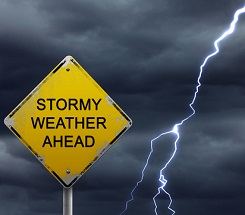Cloudy with a Chance of Learnin’
- July 12, 2012
- By Laura
 You’re caught in a rainstorm, when suddenly the sun comes out, and next a beautiful rainbow — a double rainbow at that! What makes this rainbow appear and why are there two instead of one? Learning and marveling about the weather is a great catalyst for getting kids interested and excited about science, and how it affects our everyday lives and futures.
You’re caught in a rainstorm, when suddenly the sun comes out, and next a beautiful rainbow — a double rainbow at that! What makes this rainbow appear and why are there two instead of one? Learning and marveling about the weather is a great catalyst for getting kids interested and excited about science, and how it affects our everyday lives and futures.
Research, Experiment, Discover
What’s going on with the weather is something that we all care about and all kids can relate to. It affects what we wear, what we do, where we want to live, what we eat and drink. Last year my family and I had the fortunate opportunity to visit relatives in Singapore. The weather was the first thing you noticed — it’s hot and humid and hits you like a ton of bricks. During our stay there, we observed how the weather led to the popularity of certain kinds of foods and drinks, recreational activities, and plants and animals that flourished. Also, we learned how Singapore’s close location to the equator was the reason for the hot and humid weather, with little seasonal change.
But it doesn’t, of course, take a trip to a foreign country or extreme climate to appreciate and understand the effects of weather. Have your child pick a country or region they’re particularly interested in, then have them learn why certain animals and plants thrive there. They can also examine what fruits and vegetables are frequently eaten there, how homes are designed to adapt to their weather, and what precautions are taken to guard against potential local natural disasters.
Experimentation is always a wonderful hands-on tool to grab the attention of even the most reluctant young participants. With just a few simple ingredients and supplies, kid can do very simple experiments at home and be amazed on how weather phenomena and disasters come about. Simply doing a quick Internet search on any of these experiment titles will produce the instructions and even videos on the how-to for these fun weather experiments:
* Tornado in a jar
* Make a rainbow
* Make a volcano
* Create lightning
* Launch a weather balloon
At Home and Beyond
Kids can also read and learn about natural disasters—such as hurricanes, earthquakes, wildfires, floods, and tsunamis—happening both at home and afar. Why do they happen? Why should I care? How do they affect the daily lives of people living where the disasters are happening?
Learning about these natural disasters can help create an understanding and empathy for what others are going through. By hearing or reading about the mechanics and huge impact of a tsunami in Japan, for example, kids can grasp how such a large natural disaster has major consequences for everyone. Parents can also supplement this topic of discussion by encouraging their kids to send relief donations. This helps them understand that although some of these disasters occurred far away, what happened and is happening is very real and serious.
In addition, weather knowledge goes hand in hand with kids caring more for their environment. They can learn about how the effects of pollution are changing our weather and climate, and also what are the future effects of those problems. How do smog, chemicals in the ocean, and deforestation affect our weather and quality of life in the future?
Gorgeous and Scientific
Natural disasters aren’t the only aspects of weather, of course. Weather also includes beauty and purpose. Your kids may think rain is kind of a drag when they were planning on going outdoors to play, but it helps them understand that rain supplies our water, cleans the air and nourishes soil and plants.
As for the double rainbow, the loveliness and wonder of it is in its amazing appearance. The seven colors of red, orange, yellow, green, blue, indigo, violet in a double band is difficult to dismiss. Now add science to it and it’s awesome: There is a double reflection of the light through the raindrops. The light is reflecting twice, basically through the raindrop and the raindrop acts as a prism. Cool, huh?
Here are a few websites to get your burgeoning meteorologist started:
http://wiki.answers.com/Q/What_causes_a_double_rainbow#ixzz1tTbGGiEG